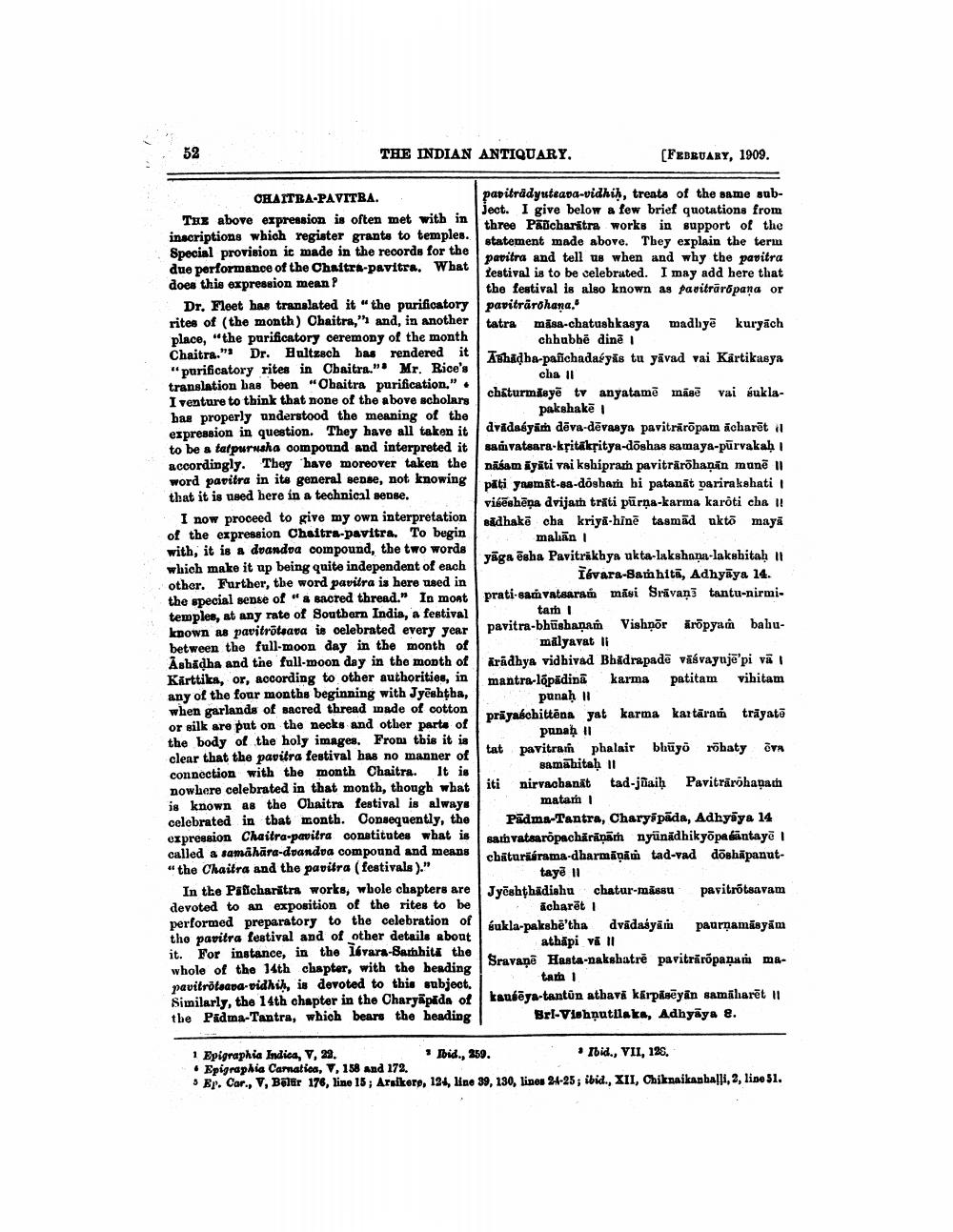________________
52
THE INDIAN ANTIQUARY,
(FEBRUARY, 1909.
CHAITRA-PAVITRA.
papitrådyuteava-vidhih, treats of the same subTus above expression is often met with in
ject. I give below a few brief quotations from
three Pancharitra works in support of the inscriptions which register grants to temples.
statement made above. They explain the term Special provision is made in the records for the
pavitra and tell us when and why the pavitra due performance of the Chaitra-pavitra. What
festival is to be celebrated. I may add here that does this expression mean?
the festival is also known as Pavitrāropana or Dr. Fleet has translated it " the purificatory paviträrghana. wite of the month) Chaitra,'') and, in another l tatramisa-chatushkasya madhyē kuryach place, the purificatory ceremony of the month
chhabhē dinē i Chaitra." Dr. Hultzsch bas rendered it
Athadha-pafichadaśyās tu yävad vai Kārtikasya "purificatory rites in Chaitra."* Mr. Rice's
cha 11 translation has been "Obaitra purification.". I venture to think that none of the above scholars
chaturmiayē tv anyatamē māsē vai suklabas properly understood the meaning of the
pakshake expression in question. They have all taken it dvidasyām dēva-dēvasya paviträropam icharēt to be a tarpurusha compound and interpreted it saivataara-kritäkritya-doshas samaya-pūrvakaḥ accordingly. They have moreover taken the nāšam iyāti vai kshipram paviträröhanin munē i word pavitra in ite general sense, not knowing
pati yaumit-sa-dosham hi patanät varirakshati ! that it is need here in a technical sense.
vibēshēna dvija trati pūrņa-karma karoti cha !! I now proceed to give my own interpretation
sidhakē cha kriya-hinē tasmādukto mayā of the expression Chaitra-pavitra. To begin
malan with, it is a dvandoa compound, the two words
yāga @sha Pavitrükhya ukta-lakshana-lakshitah 11 which make it up being quite independent of each
Isvara-Sanhita, Adhyâya 14. other. Further, the word pavitra is here used in the special sense of "& sacred thread." In mont prati sa vatsara mási Sravani tantu-nirmitemples, at any rate of Southern India, a festival
tam ! known as pavitroteava is celebrated every year pavitra-bhushanam Vishnor äröpya bahubetween the full-moon day in the month of
milyavat li Ashādha and the full-moon day in the month of Krädhya vidhivad Bhadrapadē vasvayuje'pi vā Kárttika, or, according to other authorities, in mantra-lõpädinā karma patitam vihitam any of the four months beginning with Jyệshtha,
punaḥ 11 when garlands of sacred thread made of cotton
priyabchittēna yat karma kartära träyatā or silk are put on the necks and other parts of
punaḥ 11 the body of the holy images. From tbis it is clear that the pavitra festival has no manner of
tat pavitran phalair bhūyöröbaty Ova connection with the month Chaitra. It is
samabitah 11 nowbere celebrated in that month, though what | iti nirvaobanat tad-jnaih Pavitraröhanat is known as the Ohaitra festival is always
matar celebrated in that month. Consequently, the | Pūdma-Tantra, Charyāpāda, Adhyâya 14 expression Chaitra-pavitra constitutes what is samvatsaröpachärānām nyünādhikyöpa säntay ! called a samahāra-duandva compound and means
cbāturasrama-dharmāņām tad-vad dõbhāpanut" the Chaitra and the pavitra (festivals)."
taya 11 In the Paticharitra works, whole chapters are Jyoshțbūdishu chatar-mássu p avitrātsavam devoted to an exposition of the rites to be
ācharēt performed preparatory to the celebration of
sukla-paksbē'tha dvādaśyām paurņamāsyām tho pavitra festival and of other details about
athāpi va II it. For instance, in the isvara-Sathit the whole of the 14th chapter, with the heading
Sravaņē Hasta-nakshatrē paviträrõpanam mapavitrötoava-vidhih, is devoted to this subject.
tan Similarly, the 14th chapter in the Charyapada otkausēya-tantün athava kärpäsēyan samāharēt 11 the Padma-Tantra, which bears the heading Brl-Vishnutilaka, Adhyāya e.
1 Epigraphia Indica, V, 22.
* Ibid., 259.
Ibid., VII, 128, Epigraphia Carnatica, V, 158 and 172. Br. Car., V, Ballir 176, line 15; Arsikere, 124, line 39, 130, lineu 24-25, ibid., XII, Chiknaikanhalli, 2, line 51.




